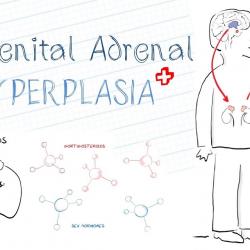Congenital adrenal hyperplasia (CAH) is a group of inherited disorders of the adrenal gland, small triangular organs located on top of the kidneys that secrete hormones. CAH is associated with deficiencies in the enzymes required for the production of the steroid hormones cortisol and/or aldosterone.
In the adrenal gland, cholesterol is turned into a precursor called pregnenolone and then several enzymes complete the production of aldosterone, cortisol, and androgens. If one or more of these enzymes is deficient or dysfunctional, then inadequate amounts of the final products are produced. Because low concentrations of cortisol cause a pituitary hormone that stimulates adrenal growth and hormone production (adrenocorticotropic hormone, or ACTH) to become elevated, the adrenal gland increases in size (called hyperplasia). However, the increased size and activity cannot overcome the block in cortisol production. Other substances (such as 17-hydroxyprogesterone) that do not need the defective enzyme will be produced in excess. The vast majority of CAH cases are due to a deficiency in the enzyme 21-hydroxylase, so this type will be the main focus of this article.
With CAH, the enzyme deficiency can cause a decrease in cortisol concentration and/or aldosterone and, in some cases, an increase in androgens, a group of "male hormones." Excess androgens can result in the development of male sexual characteristics in females (virilization), which is often noticed at birth. A baby girl's external sex organs may be ambiguous: her genitals may resemble a boy's anatomy or be somewhere in between a boy's and a girl's anatomy. While it is a rare disorder, CAH is the most common cause of ambiguous external sex organs (genitals) in newborns.
Males with this condition will appear normal at birth but may start to develop sexual characteristics of puberty in early childhood. Females may develop excess hair on the face and body (hirsutism) and other male secondary sexual characteristic during childhood and adolescence and have irregular menstruation. CAH may also lead to infertility in adults.
CAH enzyme deficiencies are due to mutations in specific genes. They are autosomal recessive, which means that it takes two copies of the gene mutation, one inherited from each parent, before a person will be affected by CAH. A person with one copy will be a carrier but will not typically have any symptoms.
About 90% of CAH cases are due to a 21-hydroxylase deficiency, which is caused by a mutation in the CYP21A2 gene. Those affected may have a classic (more severe) or nonclassic (less severe) type. About 75% of those with a classic deficiency will have a "salt-wasting" form that includes decreased aldosterone and leads to an excess loss of fluids, low sodium, and high potassium that, when severe, can be life-threatening.
The National Institute of Child Health and Human Development in the United States estimates that classic CAH affects about one in 15,000 babies worldwide, while non-classical CAH affects about one in 1,000 people. CAH can occur in people of all ethnicities but is more common among Ashkenazi Jews, Yupik Eskimos, and those of Hispanic, Slavic, or Italian descent.
Several other rare inherited enzyme deficiencies can also cause CAH. Of these, 11-beta-hydroxylase deficiency is the most common, accounting for about 5-8% of CAH cases, and 17-alpha-hydroxylase and 3 beta-hydroxysteroid dehydrogenase are less common. The signs and symptoms that are experienced by males and females with CAH will depend upon which enzymes are deficient and the severity of the deficiencies. For more information on these less common types of CAH, see the links on the Related Pages page.


